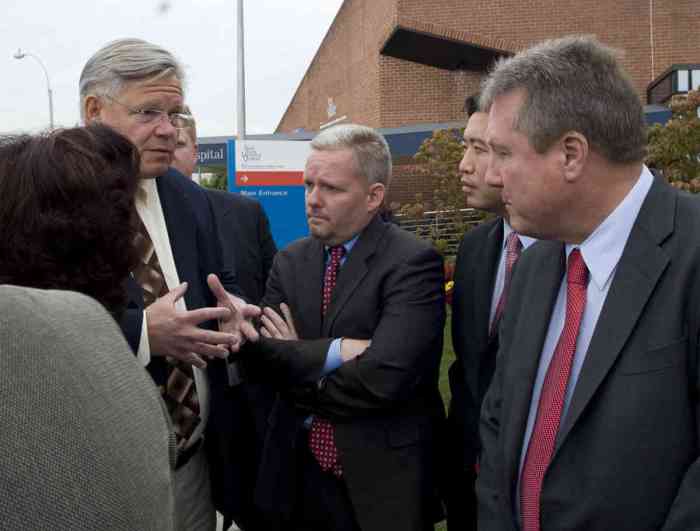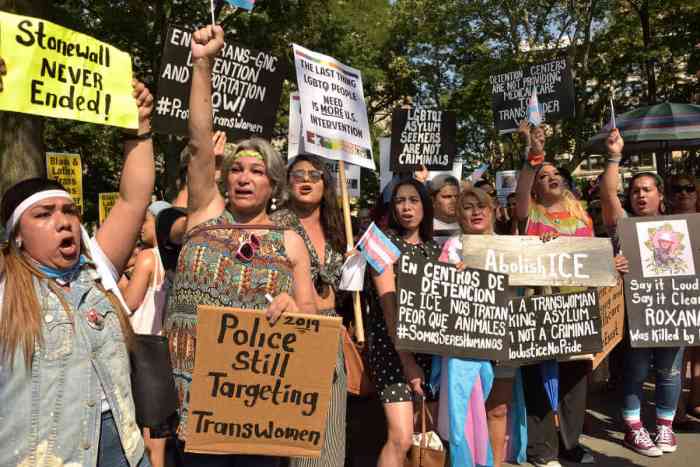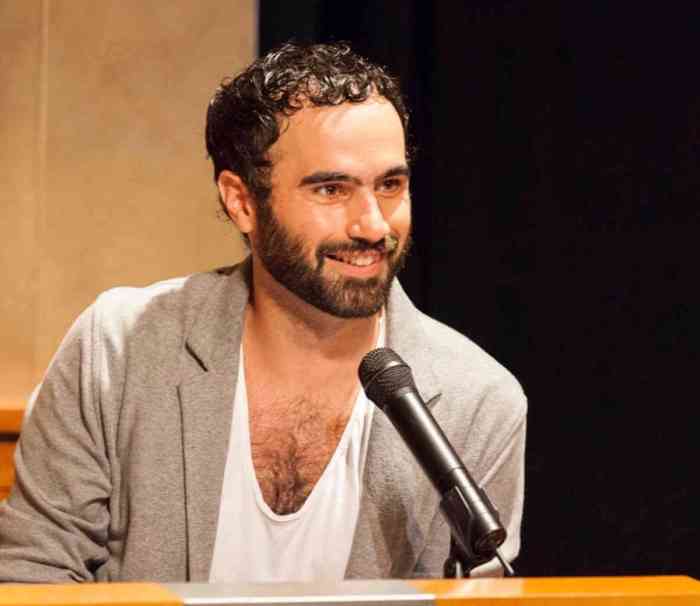A rendering of Anthony Goicolea’s design for the LGBT Memorial planned for Hudson River Park, showing the glass prisms in the rock design as well as the rainbows they cast on the surrounding grass. | OFFICE OF THE GOVERNOR
Monuments to cataclysm — from the Vietnam War Memorial wall in Washington bearing the names of tens of thousands of American soldiers killed in that divisive US “police action” to the 9/11 Memorial waterfalls marking the site of the obliterated World Trade Center towers and the thousands who perished that day — are almost invariably erected in controversy, at least at first.
The winning design announced by Governor Andrew Cuomo at the end of Pride Month for the LGBT Memorial in Hudson River Park to “honor the LGBT community and the victims of the Orlando shooting” at the Pulse club in 2016 was met by an unusual amount of criticism, while staunchly defended by the members of the selection commission that recommended three designs as well as others who praised its “strength and depth.”
Cuomo picked Anthony Goicolea’s plan for an arrangement of “nine modified boulders, some of which are bisected with a clear, laminated, borosilicate-glass with refractory components that act as a prism to create subtle rainbow patterns on the surrounding lawn and nearby objects.”
What critics sees as bland, banal, defenders laud as deep, universal, enduring
Goicolea, a Cuban-American artist born in Georgia who now lives in Brooklyn with his husband, told Gay City about his concept for “a circular stone formation made out of bronze and finished to look like granite or fieldstone. Six will be bisected by glass prisms and one split in half with interior faces polished and with texts” that, he said, will on one face “memorialize members of the LGBT community who have been victims of hate crimes,” though no names of victims will be etched there. The other face will feature “poetic texts that will celebrate the diversity and endurance of the LGBT community.”
“If you include names, it creates a cut-off,” Goicolea explained, and anti-LGBT violence “is an ongoing issue.”
The artist said he was inspired by “circular formations — divine structures throughout history that encourage communal gathering,” citing Easter Island, Stonehenge, megalithic stone structures in Africa, pre-Colombian burial grounds, and others in Ireland. “That kind of circular formation crops up again and again and is a unifying element for humanity.”
Goicolea told the New York Times, “I wanted something usable and functional and that was not going to take away part of the space. I wanted to communicate with the river and the piers. I really want it to be part of the area.”
Cuomo called it “a stunning design,” but some LGBTQ activists were just stunned.
Matt Foreman, the executive director of the New York City Anti-Violence Project from 1990 until 1996, among numerous community leadership posts, said, “This design is an insult to LGBT victims of violence. Hate has never broken or scattered us, like this design suggests. It’s only made us stronger.”
Beverly Tillery, who is AVP’s current executive director and served on the commission, offered a different reaction, saying, “We wanted to make sure that this design created a space where people could come and be reflective individually or in groups and have time and space to learn about the history of violence whether they didn’t know about it or if they have been survivors or affected by it — a place where people can come together and talk about what we can do about it.”
Tillery acknowledged, “For any project like this, some will love it and some will hate it.”
Duncan Osborne of Queer Nation — and Gay City News’s associate editor — wrote on Facebook, “We have an AIDS memorial just a stone’s throw from the location for this memorial that has zero names of people who died from AIDS and is commonly referred to as a bus shelter though Sarah Schulman recently called it a dish rack or a spaghetti strainer or a colander or some other utensil… Now this memorial proposes to not mention anyone who is LGBTQ. Memorials must name the people they are recalling.”
Elsewhere on social media, reaction varied widely.
The location planned for the LGBT Memorial. | OFFICE OF THE GOVERNOR
Gay activist Gregg Kapuscinski wrote, “I would like to keep an open mind about this, but 9 rocks and some reflective glass seem uninspired, flat, and sad. Stumbling upon this and not knowing what it was I would walk right past it.”
But Ted Thompson’s response was, “They look like a prayer circle, a fitting tribute to those whose lives were so brutally cut down.”
And Anthony Accardo wrote, “I am familiar with Anthony Goicolea’s work. At first glance this memorial may seem underwhelming, but the subtleties of the work do speak to the everyday lives of the victims. The reflected rainbows created by the rocks inserts and the solid nature of stone reveal both strength and depth. I don’t believe a plaque with names or some representational sculpture would feel as universal or timeless.”
Referring to the portion of Central Park long renowned for gay cruising, Robert Pell-deChame wrote, “Why recreate The Rambles when [the park’s landscape architects] Vaux & Olmsted did it so much better? Put a plaque up there.”
And Jay Vithalani wrote, “This appears to be a generically pleasant grassy leafy space with some rocks to sit on and some rocks to look at — and some prisms cuz of course rainbows. What is this evocative of or a *memorial* to — besides some idea of a futuristic gay pastoral? Given the banality — seen through the artist rendering at least — of the result, invective doesn’t even seem worth it. The task was immense and admittedly impossible, as all monumental projects of fissiparous tendencies are impossible. How do you acknowledge and honor so very much, in all its bewildering and indeed contradictory complexity? And yet, artists have risen to that challenge of public-monument impossibility before. What I see here is not a rising-up to the task so much as a sidestepping abdication of it (and not in the spirit of artistic abnegation). Blandness, at least, can never be (publicly) offensive after all.”
But Jackie Rudin of Gays Against Guns did find offense in the design, saying, “These rocks look like graves where we — and our issues — are buried and gone, rather than memorials where our strength, love, and persistence will live on forever. I find it repulsive, insulting, and degrading.”
Eunic Ortiz, a former president of the Stonewall Democratic Club of New York City and one of the few commissioners who does not work for an agency receiving state funds, said, “As a Latina, I was very proud to see they chose a design from someone of Latino descent because of who we lost at the Pulse — mostly Latinx people.”
She added, “I see this at first as something dark, but then the light shines through and our rainbow shines bright. And I truly feel that is the core of our community. No matter what obstacle we may face or road block we have to overcome, we always stand strong and shine forward in the fight for equality.”
Jay W. Walker of Rise and Resist said, “The fact that they chose this design rather than the one proposed by the late, great Gilbert Baker shortly before he died — a design that included a permanent Rainbow Flag that LGBTQ+ activist have been clamoring for for years — is the latest example of a tone-deaf, straight, cis political class completely devoid of any understanding of our communities and needs.”
Baker’s close friend Charley Beal said that while he is “thrilled” by the Stonewall landmarking and this new memorial, “it is time for New York to come out of the closet and create a monument to LGBTQ visibility by erecting a 100-foot flagpole with a giant Rainbow Flag on the Hudson River waterfront at the foot of historic Christopher Street.”
Beal intends to carry on Baker’s quest for such an installation.
Activist and artist Ronald Madson questioned how the winning design would “reflect the centuries of oppression here in the USA and the struggle to get to that modicum of freedom. If the scale shown is the one to be executed, it misses the enormity of the obstacles we have had to overcome, the enormity of our losses, and the struggles we still face.”
Cristina Herrera, founder and CEO of the Translatina Network, another commissioner, said the Goicolea design is “a powerful work of art. We were worried about a monument outdoors on the waterfront that can be impacted by weather. It had to have great endurance to be everlasting. It is very welcoming and open and many people can be within the space and celebrate who are as community.”
The selection commission was overseen by Alphonso David, the governor’s out gay counsel. Other commission members were Scott P. Campbell, executive director of the Elton John AIDS Foundation; Rose Harvey, commissioner of the State Office of Parks, Recreation and Historic Preservation; Thomas Krever, CEO of the Hetrick-Martin Institute; Kelsey Louie, CEO of Gay Men’s Health Crisis; Christine Quinn, the former City Council speaker who is now CEO of Women in Need; Melissa Sklarz, development director at the Transgender Legal Defense and Education Fund; and Glennda Testone, executive director of the LGBT Community Center.
While the commission consulted with two art and architecture experts, their names were not released nor were the 40 other submissions for the $800,000 commission. There was no opportunity for the public to comment on any of the designs.
David said, “There are no additional formal processes” in the selection process, but “as we go through process of installing, we want community to be engaged. We will hold community forums. Will keep elected officials informed.” He added that the other designs would be released once the winner goes through a contracting process.
David called the “underlying premise” for the memorial “challenging,” saying, “This proposal that the commission approved reflects what we were seeking to do — a memorial that reflects pride and tolerance and acceptance within the LGBT community. We hope that when it is installed and fully put in place [in a year] that the majority will see value in it.”



































